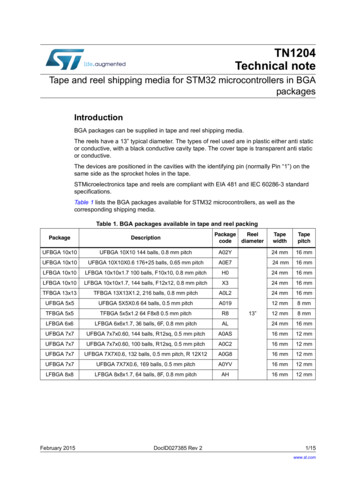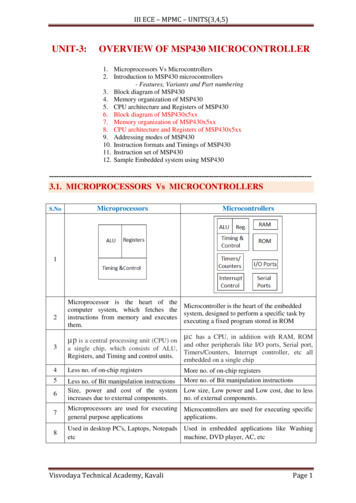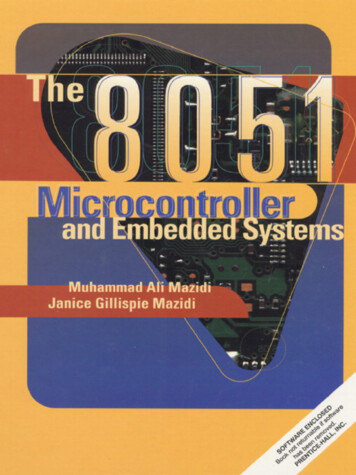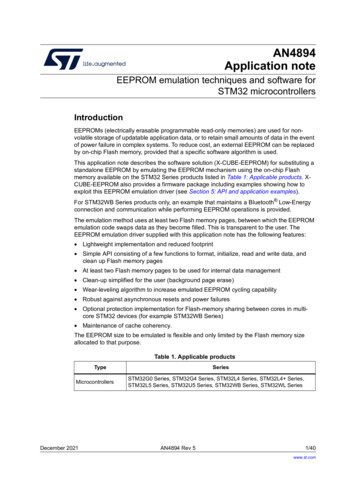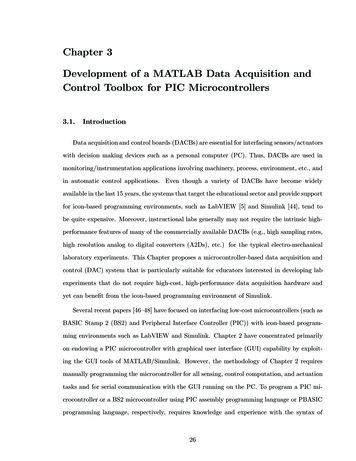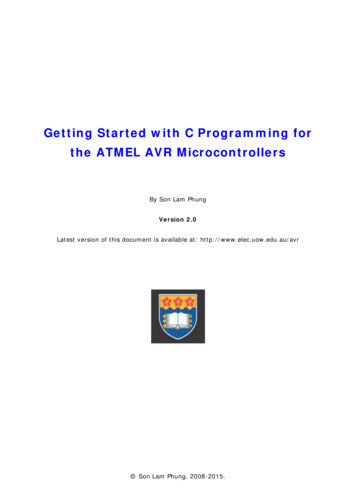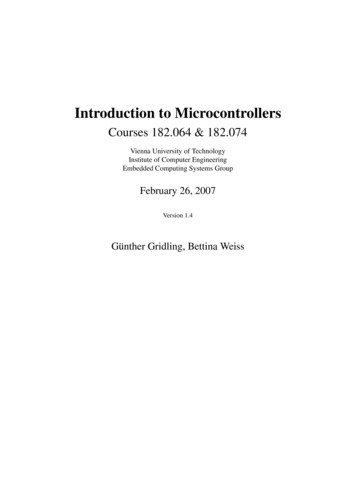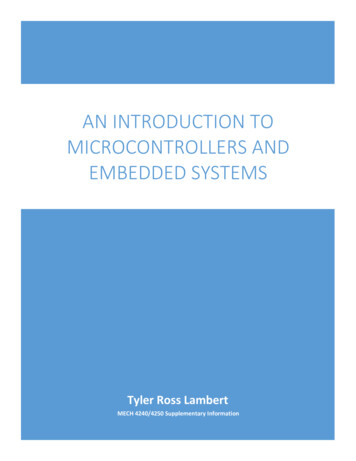
Transcription
AN INTRODUCTION TOMICROCONTROLLERS ANDEMBEDDED SYSTEMSTyler Ross LambertMECH 4240/4250 Supplementary Information
Last Revision: 6/7/2017 5:30 PMSummaryEmbedded systems in robotics are the framework that allows electro-mechanical systems to be implementedinto modern machines. The key aspects of this framework are C programming in embedded controllers,circuits for interfacing microcontrollers with sensors and actuators, and proper filtering and control of thosehardware components. This document will cover the basics of C/C programming, including the basicsof the C language in hardware interfacing, communication, and algorithms for state machines andcontrollers. In order to interface these controllers with the world around us, this document will also coverelectrical circuits required to operate controllers, sensors, and actuators accurately and effectively. Finally,some of the more commonly used hardware that is interfaced with microcontrollers is gone over.Table of Contents1.Introduction . 42.Numbering Systems . 53.Variable Types and Memory. 64.Basic C/C Notes and Code::Blocks . 95.Bitwise Operations . 106.Arrays and Matrices . 117.Loops. 128.Logical Statements . 139.Enumerations . 1410.Compiler Directives . 1511.Pointer Variables . 1612.Functions . 1813.Structures . 2014.Microcontrollers and the Arduino IDE . 2215.Electricity and Basic Electronic Components . 25Electricity . 25Resistors . 30Capacitors . 33Inductors . 36A Note on Reactive Power and AC Power Sources. 38Solid State Relays . 41Diodes . 42Bipolar Junction Transistors (BJT) . 45Metal Oxide Semiconductive Field Effect Transistors (MOSFET) . 47Operational Amplifiers . 50Batteries . 511
Last Revision: 6/7/2017 5:30 PMVoltage Regulators. 5316.Kirchoff’s Laws and Basic Useful Circuits . 54Simple Voltage Divider . 54Analog First Order Low Pass Filter . 55Analog First Order High Pass Filter . 57Amplifier/Follower . 5817.Analog to Digital Conversion (ADC) . 60ADC Library for Teensy Microcontrollers . 6318.Pulse-Width Modultion and Digital to Analog Conversion (DAC) . 68Logic Level Conversion and H-Bridges . 7120.Mechanical Switches and Switch Debouncing . 7821.Interrupts and Interrupt Service Routines (ISRs) . 8222.Analog Sensors (Accelerometers) . 8423.Serial Communication. 87UART Signals . 87SPI Signals . 95I2C Signals . 102CAN Bus . 108OneWire Bus. 11024.Digital Filters . 112Discrete Low Pass Filter . 112Moving Average Filter . 113Over-Sampling . 113Median Filter. 114Velocity Filters. 11425.Creating Your Own C Libraries . 11526.Rotary Encoders . 11827.Load Cells . 12228.Electric Motors. 125Stepper Motors . 125DC Motors . 13129.Thermocouples . 13430.Telemetry and Wireless Data Transmission . 13631.Data Storage . 14233.Soldering . 1472
Last Revision: 6/7/2017 5:30 PM34.Electronic Packaging. 149Conclusions . 162Additional Resources . 1633
Last Revision: 6/7/2017 5:30 PM1.IntroductionAn embedded system is a computer system with a specific, dedicated function that is not designed so thatit should ever need to be reprogrammed (i.e. engine control units, implantable medical devices, appliances,etc.) The most common type of embedded system is a microcontroller, which is a small computer systemon a single integrated circuit. Some common examples of this type of embedded system comes in the formof Arduino or Teensy microcontrollers (Figure 1).Figure 1. (left) Arduino Uno Microcontroller (right) Teensy 3.2 MicrocontrollerMicrocontrollers are adept at performing tasks such as reading sensors and implementing control laws, butit is important to note that these devices are digital, which means they are discretized in how they interpretdata, in contrast to the real world in which we live which is analog, so that everything we see is continuousin nature. In order to reconcile this, a microcontroller will utilize both digital-to-analog conversion (DAC)to move from binary values to actual output voltages and analog-to-digital conversion (ADC) to movefrom an input signal to digital data that the microcontroller can use.Two of the more common microcontrollers are the Arduino and the Teensy models, which will be theones primarily discussed in this document. Older microcontrollers, such as a PIC microcontroller, mightbe better suited for alternative tutorials.There are countless factors that go into selecting which microcontroller is the most suited for any specificproject. Different microcontrollers have different sizes, different functionalities, different feature tofootprint ratios, different software architectures, varying number input/output (I/O) pins available for use,different power requirements, different processing speeds, etc.4
Last Revision: 6/7/2017 5:30 PM2.Numbering SystemsA numbering system is simply a way in which to represent a quantity. The most common numberingsystem in use is the decimal system (base 10), but other numbering systems such as binary (base 2) andhexadecimal (base 16) are often convenient to use. These numbering systems use symbols (numericindicators) up to the value of the base in order to express a quantity. For example, the binary system usesthe symbols 0 and 1. The decimal system uses 0, 1, 2, 3, 4, 5, 6, 7, 8, and 9. The hexadecimal numberingsystem uses the symbols 0, 1, 2, 3, 4, 5, 6, 7, 8, 9, A, B, C, D, E, F, where A represents the number 10 indecimal, B represents 11, and so on.These symbols will be placed in a location in the number, and this location is known as its digit. The digitlocation, starting from right to left (reflecting smallest to largest quantity) is designated by a subscript onthe constants in the following table that shows how each numbering system functions with respect to thesedigits and the system’s base value (the mathematical expression being the conversion from the system tothe standard decimal notation):Numbering matical Expression𝐷 𝑑2 102 𝑑1 101 𝑑0 100𝐵 𝑏2 22 𝑏1 21 𝑏0 20O 𝑜2 82 𝑜1 81 𝑜0 80𝐻 ℎ2 162 ℎ1 161 ℎ0 160Example. What is the decimal representation of the hexadecimal value A6?𝐴6 𝐴{10} 161 6 160 𝟏𝟔𝟔To designate which numbering system is being used, common practice is to have the number be precededby 0d (for decimal), 0b (for binary), 0o (for octal), or 0x (for hexadecimal).5
Last Revision: 6/7/2017 5:30 PM3.Variable Types and MemoryData in a microcontroller is stored at its basest level as binary values. Each digit of a binary value is termeda bit. A collection of eight bits is known as a byte. This means that the working range for a byte is between0b00000000 and 0b11111111 (which corresponds to decimal 0 to 255). This convention was started, inpart, because of ASCII codes. In hexadecimal, a byte can range in value from 0x00 to 0xFF. Note that 4bits of binary corresponds with one hexadecimal digit.When a variable in a microcontroller is initialized, its value is stored using bytes. There exist severalfundamental variable types/structures available for use (called type definitions): Integers – whole numbers, can be stored as signed values or unsigned valuesFloat – short for floating point precision, can store decimal valuesDouble – short for double point precision, can store decimal values with twice the precision as afloat.Characters – unsigned eight byte values which are initialized as charactersBoolean Values – values that are either 0 or 1An integer takes binary values and gives the corresponding decimal value, if it is an unsigned integer. If itis a signed integer; however, the first bit corresponds with the sign of the value (0 for positive, 1 fornegative). A basic example chart is below for three bit binary values:Table 1. Three-bit binary Corresponding Signed and Unsigned Integer ValuesBits0110100010b000101110111100Unsigned Integer Value32105674Signed Integer Value3210-1-2-3-4For an eight-bit unsigned integer, values between 0 and 255 can be stored. For an eight-bit signed integer,this range is shifted to -127 to 127. To add or subtract signed binary values, use the two's complementmethod where each bit is inverted before being added or subtracted to yield the correct result.The most important thing to note about integers is that they do not store any information behind thedecimal point. Any calculations involving integers that results in non-integer values will truncate anythingafter the decimal point, which can ruin the computation. This can be addressed by scaling up the integervariable values to avoid decimal places during calculation to some certain level of precision, but this isoften not convenient.Numbers that are stored as floating point types have the following four-byte data structure:𝑓𝑙𝑜𝑎𝑡 ( 1)[𝑠𝑖𝑔𝑛] (1 [𝑚𝑎𝑛𝑡𝑖𝑠𝑠𝑎]) �]6
Last Revision: 6/7/2017 5:30 PMThese bracketed values correspond to information stored in the binary of the floating point number. Afloating point number is stored in four bytes (32 bits) that are structures like so:The very first bit of a float is the signed bit that dictates the sign of the value. The next eight bits ofinformation form the exponent byte, which gives an eight-bit integer value. This exponent value is biasedby -127 from the pure decimal equivalent of the byte. The next 23 bits give the mantissa (fractional part ofnumber), which is a number that ranges from 0 to 1 in decimal and is given by:𝑚𝑎𝑛𝑡𝑖𝑠𝑠𝑎 𝑀1 2 1 𝑀2 2 2 𝑀23 2 23Double point precision types use this same structure, but offer three additional bits for the exponent (so thatthe exponent can range from -1022 to 1023) and offers 29 more bits for the mantissa. This increases theprecision on decimal values over the single point precision floating point types, at the expense of eightbytes of memory storage.The character type converts a series of characters to unsigned eight bit integers. Each alphanumeric letterhas a numeric equivalent. Characters can be printed either as the character (using %c) or as their integerequivalent. Characters are NOT strings. Characters are denoted by single quotes in C (i.e. ‘A’); whilststrings use double quotes.Type IdentifiersWhen using a microcontroller and initializing variables, each variable must have its type specified uponinitialization, with the type keyword being placed immediately before the variable name. To specify aninteger variable, the keyword int (for a signed integer) or uint (for an unsigned integer) could be used,but the amount of bits allocated to an integer varies with the computer. For portability of a program, it isbetter to use the type identifier intxx t/uintxx t (where xx corresponds with the number of bits to be usedto variable storage). The type identifier for characters is char, for floating point numbers, it is float; andfor double point precision values, it is double.There are other type definitions, such as long (which is an integer value that is usually fairly large; byconvention it is twice as large as int) or bool (which is a boolean value, meaning that it is a single bitreflecting 0 or 1). Another type definition is to declare a variable a byte. This allocates exactly eight bits ofdata for the variable which when references returns an unsigned integer between 0 and 255.Example. Store a signed 16 bit integer variable as the decimal value 32.int16 t variable name 32;Attempting to store a value larger than the variable can store based on the number of bytes it is allocatedwill cause a “roll-over” effect. For example:7
Last Revision: 6/7/2017 5:30 PMThis code attempts to store 256 into an unsigned eight bit variable, despite the fact that an eight-bit unsignedbinary value can only range from 0 to 255. Because of this, the code will store the variable as the number1.Variables can temporarily be used as another type in what is known as casting. This is done by referencingthe new type in parenthesis before the variable name during a calculation. This is very useful for doingmath with integers, because it allows the user to avoid having decimals points truncated.Example.This returns var1 0.3 as a floating point number.UnionsIf one space in memory is requested to store a variety of data types, unions can be used to accomplish thistask. A union is a special data type available in C that allows to store different data types in the samememory location. You can define a union with many members, but only one member can contain a valueat any given time. Unions provide an efficient way of using the same memory location for multiple-purpose.The syntax can be seen from the following example, initialize the union Data to store an integer, a floatingpoint number, and a character string:The memory occupied by a union will be large enough to hold the largest member of the union. Forexample, in the above example, Data type will occupy 20 bytes of memory space because this is themaximum space which can be occupied by a character string. To store this union as any of these data types,the following type of code could be used:8
Last Revision: 6/7/2017 5:30 PM4.Basic C/C Notes and Code::BlocksTo begin playing around with C and/or C , one great open source program to use is Code::Blocks.The download link is available on their website here. Code::Blocks is a free, open source program thatsupports many compilers for several different programs, so it’s a nifty tool for anyone looking tobecome proficient in a language. The program also has full breakpoint support, meaning that the codecan be stepped through line by line in debug mode, which is a luxury that a microcontroller will notafford the user.NOTE: Upon downloading Code::Blocks, make sure to follow the instructions to include the GNUGCC compiler. If installed correctly, inside of the Code::Blocks folder (likely inside of C:\ProgramFiles (x86)\CodeBlocks), there should be a folder called MinGW. C projects can either be created as a header file (.h) or a source file (.cpp). For execution ofcode done for practice, the source file is the project type that should be chosen.In C, code is executed in loops. The main() loop is the heart of the code, and returns valuesof the variable type indicated by the type identifier keyword specified immediately before theloop. The value to be returned is addressed by the return statement.A hashtag (#) indicated a compiler directive, meaning that these parts of the code are executedwhile the code compiles. A common example is thestatement, which allows foradditional libraries to be added to the program. A library is additional code that can establishfunctions for the user of the library to call upon instead of having to code them themselves.Several important libraries are required to utilize the full functionality of Code::Blocks, andthese are shown along with their compiler directive to below: The sizeof(input) function reveals the size, in bytes, of the input expression.The printf(“string”, var1, var2, ) function operates the same as in MATLABConstants can be declared, and upon compiling of the code the constant will be replaced by itsvalue to optimize memory storage. The syntax for this is simply: Incrementing and decrementing a variable by 1 is done by using “ ” or “--" after the variablename in a line of code. This is a shortcut provided by C and C .Including the cmath.h library enables the use of mathematical functions. For example, thepow(base, exponent) function returns the value of the base input to the power specified byexponent. Other math functions include sqrt(num) that returns the square root of num, andmany more covered here.Comments are started by double backslash (i.e. // this is a comment). A multiline commentcan be initiated with an asterisk and a backslash, as shown: /* . */A semicolon (;) terminates a line of code, and is required at the end of each completed line ofcode. 9
Last Revision: 6/7/2017 5:30 PM5.Bitwise OperationsBitshifting is the mathematical operation denoted by “ ” and “ ” that shifts every bit over to the left orto the right, respectively.Example.This can be extremely useful in the situation where the user has two eight bit numbers and wishes tocombine them into a sixteen bit value. The following code would accomplish this task:This code would return the decimal equivalent of 0b1111101000100010, or 64,034. Should this has onlybeen allocated eight bits of memory, it would have only returned 34, the value of low byte, because thevariable would only use the lowest eight bits of information.The bitwise NOT operation turns all 0s in a binary number into 1s and vice versa. In C , this operationis denoted with a tilde character ( ), like so:The bitwise AND operation is denoted by combining two binary values with an ampersand character (&).This operation will return a 1 in place of a digit of the new binary value if both of the combined binaryvalue have a 1 as that digit, and will return a 0 for that digit otherwise, like so:The bitwise OR operation is denoted by combining two binary values with a vertical bar character ( ). Thisoperation will return a 1 in place of a digit of the new binary value if either of the combined binary valuehave a 1 as that same digit, and will return a 0 if both binary values have a 0 as that digit, like so:The bitwise XOR (exclusive OR) operation is denoted by combining two binary values with a caratcharacter ( ). This operation functions like an OR operation in that a 0 is returned if both binary valueshave a 0 for that digit, and a 1 is returned for the digit if either binary value has a 1 as that digit, but whereasthe bitwise OR will return 1 if both binary values have a 1 as the digit, the XOR operation would insteadreturn 0, like so:10
Last Revision: 6/7/2017 5:30 PM6.Arrays and MatricesArrays are group of values that span in a list. Each value of an array must be of the same data type, specifiedby the type identifier before the array. The syntax for initializing an array in C is given in the followingexample:The number in the square brackets is the number of elements in the array, and the array values are containedwithin the curly brackets. Arrays in C are zero-indexed, so the index of array values starts at 0 (unlike inMATLAB, where the first entry in an array is index 1). To reference a value in an array, take the followingexample:This will simply return the string “val 842”.Matrices are groups of information that is stored in columns as well as rows. If an array is a 1-D dataelement, then a matrix would be considered a 2-D data element. Matrices in C are initialized with thefollowing syntax:The first value inside of the square brackets is the number of rows, while the second is the number ofcolumns. Referencing the values inside of a matrix is the same as with arrays, with the indexing starting at[0,0].A very useful library exists in the form of MatrixMath.h that enables some matrix math functions that arecommonly employed to be used from within C Code. The library is available on Arduino’s website and islocated here. It enables matrix or vector algebra and includes the following functions: vertThe exact syntax and how to use the library is available in the attached link. Be forewarned to check thedimensions of your matrices beforehand, as this library will not return an error if matrix dimensions aremismatches.11
Last Revision: 6/7/2017 5:30 PM7.LoopsAn iterative loop is a block of code that repeats itself a set number of times. Two main examples of theseare for loops and while loops.An example of while loop syntax is given below:This example code will run the loop three times over, incrementing the counter index up by one upon everyiteration of the loop.A for loop is initialized via for(variable, condition, increment). The variable in this expressionmust have its type defined, but the general syntax for a for loop can be demonstrated with a simple example:This code accomplishes the same task as the while loop above. C also allows for a do while loop, whichis essentially a while loop that is guaranteed to run at least one time, but rarely can such a task not beaccomplished with a for or a while loop.Note that in C, any variable created within a loop can only be accessed inside of that loop or at even lowerlevels within loops that are nested inside of that loop. The areas of the code where the variable can bereferenced is known as the variable’s scope. If the variable is created outside of the loop, and is changedwithin the loop, the changed value is the value that will be accessed when the variable is accessed. Notethat in this context, loop does not only refer to iterative loops, but to any block of code bounded by brackets.This includes function expressions and even the main loop itself.12
Last Revision: 6/7/2017 5:30 PM8.Logical StatementsThe standard if/else logic used in most other languages is present in C, using the following syntax:Make note of the double equals sign symbols inside of the if statement. This corresponds with logicaltests, whereas a single equals sign corresponds with assigning a variable a new value. The logical tests thatcan be used include:The standard switch/case alternative to if/else logic does exist in C/C . The syntax of this is seen belowin a simple example:This example all takes place inside of the main() loop, and prints different results based on the result ofthe input of the variable grade.13
Last Revision: 6/7/2017 5:30 PM9.EnumerationsAn enumeration consists of a set of named integer constants (called the "enumeration set," "enumeratorconstants," "enumerators," or "members") and is considered a variable type. An enumeration type isinitialized with enum. The elements inside of the enumeration, for all intents and purposes, behave thesame as constants upon compilation of the code.The example below demonstrates its usage:This code would return a day based on the input of day value.14
Last Revision: 6/7/2017 5:30 PM10.Compiler DirectivesA compiler directive tells the compiler to compile or skip blocks of code during compiling based on somecriteria during preprocessing of the code. These statements are prefaced with the hashtag symbol and arevery helpful in regards to memory storage. Note that no semicolon is required to terminate the end of a lineof code that consists of a compiler directive. An example is provided that would place the program in debugmode ba
Embedded systems in robotics are the framework that allows electro-mechanical systems to be implemented into modern machines. The key aspects of this framework are C programming in embedded controllers, circuits for interfacing microcontrollers with sensors and actuators, and p
